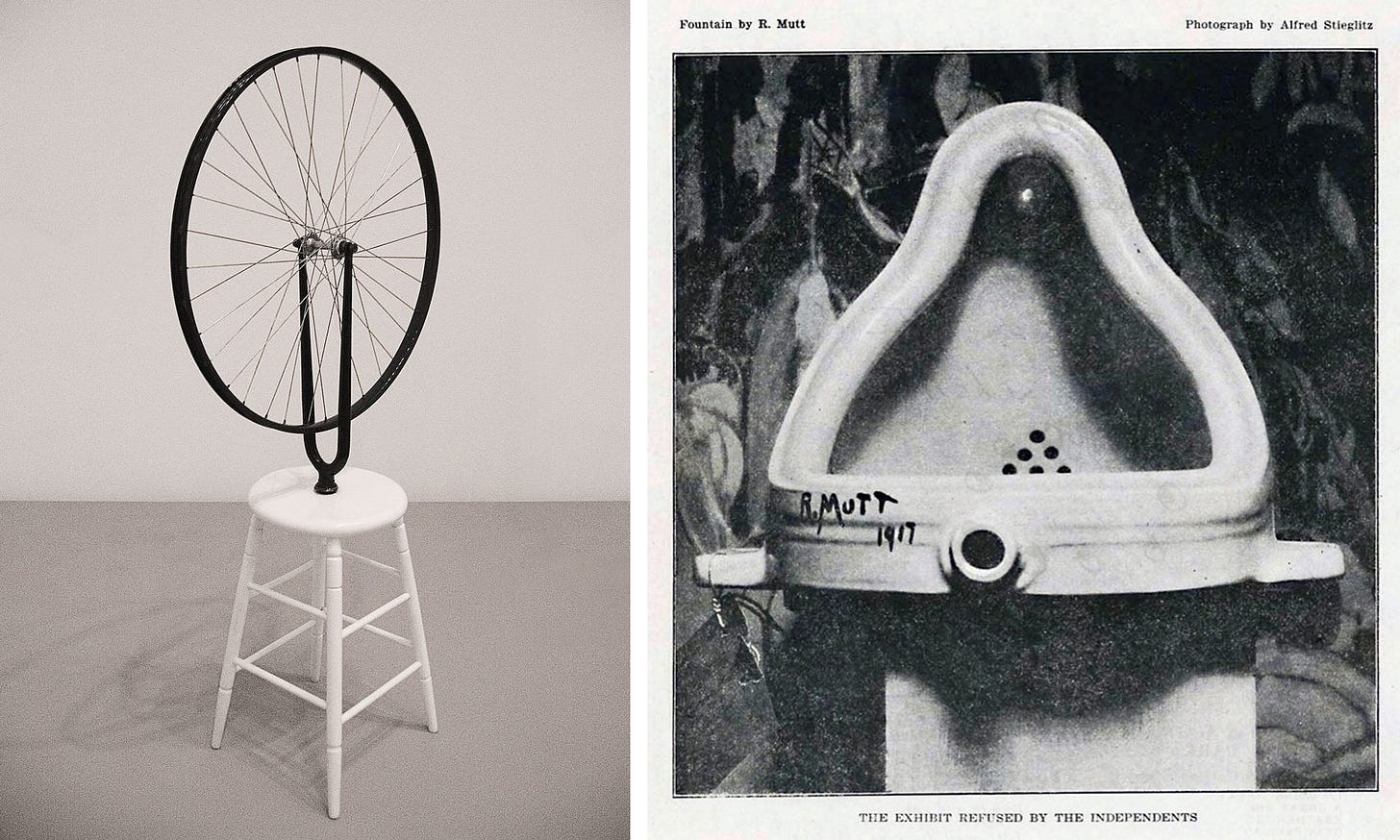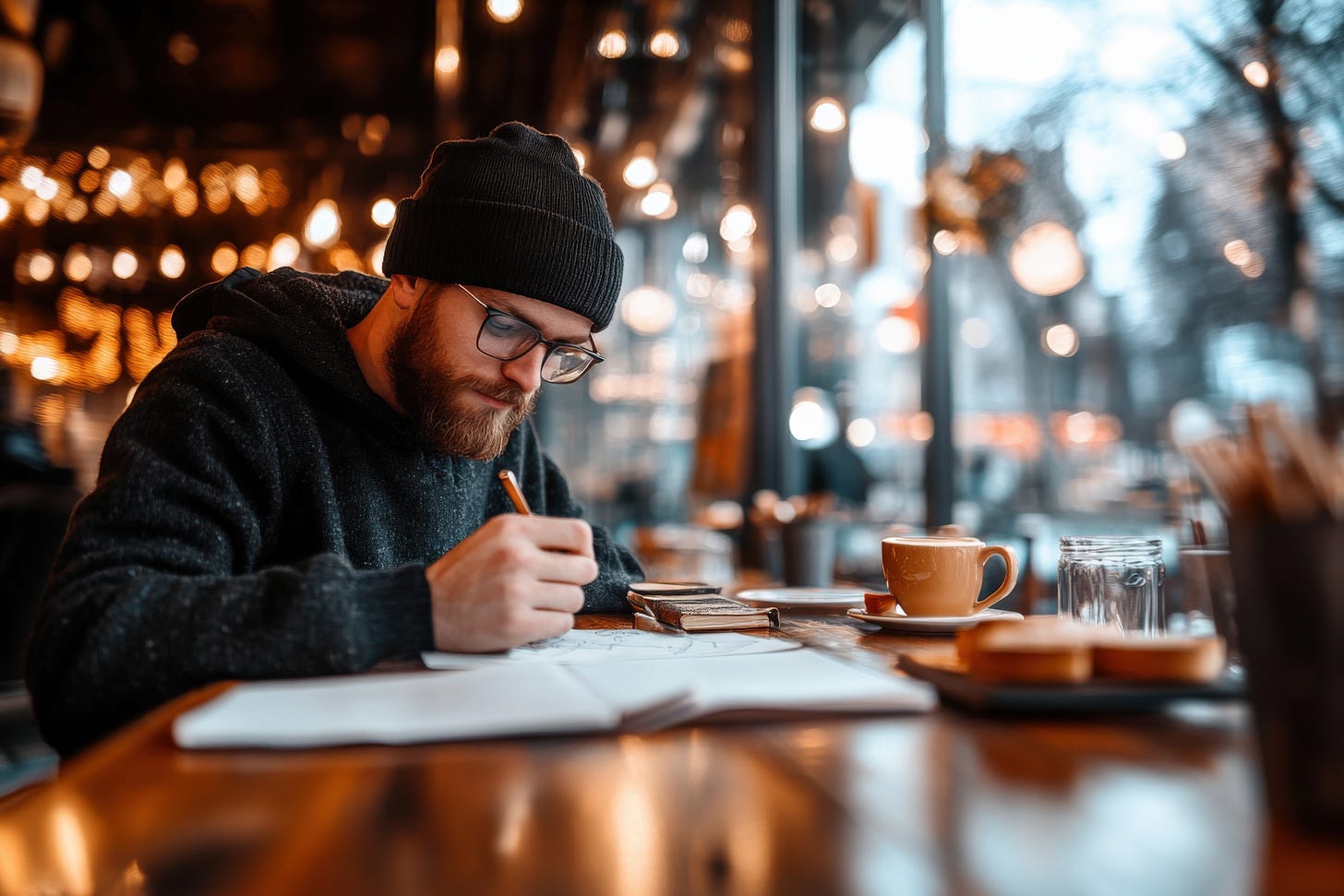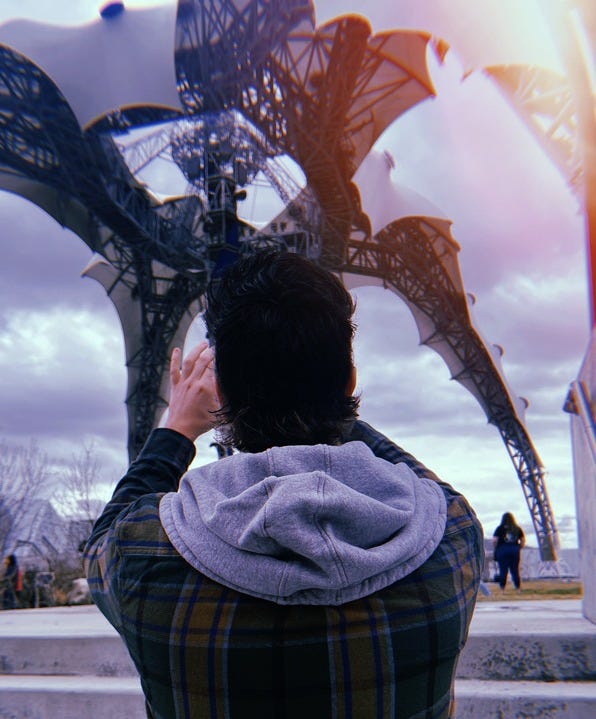The Alchemy of Displacement
Finding creative gold in the chaos of moving
You know that moment when you find your coffee mug in the bathroom and your toothbrush next to the kettle?
There I was, standing in my half-packed kitchen at 6 AM, bleary-eyed and caffeine-deprived, staring at my bookshelf, which had somehow migrated to where my dining table used to be. Cardboard boxes formed an obstacle course across the floor, each one labeled with increasingly creative shorthand as my patience for proper organization waned.
"Stuff from that drawer" was perhaps my crowning achievement in moving-day taxonomy.
But something strange happened as I stood there, surrounded by the physical evidence of my life in transition. The early morning light slanted through dusty windows, casting unfamiliar shadows across familiar possessions. My blender perched awkwardly atop my winter boots. My favorite reading lamp illuminated a stack of bath towels. My plants clustered around the front door like nervous party guests unsure if they should leave.
Everything was out of place. Nothing was where it "belonged."
And yet—in that chaotic rearrangement of my ordinary possessions, I felt a sudden spark of something unexpected.
Creative clarity.
The kind that usually only comes after three cups of coffee and a long shower.
What was happening?
When Objects Break Free From Their Assigned Roles
There's something alchemical about seeing familiar objects in unfamiliar contexts.
The salt shaker that normally lives by the stove now sits on your bookshelf, and suddenly, you notice its elegant shape—the way light catches in its glass curves, revealing tiny rainbows you've somehow never seen before.
The painting that has hung in your hallway for a year now leans against your bedroom wall at an odd angle. The colors vibrate differently in this new light, and the brushstrokes tell stories your eyes had stopped reading long ago.
This isn't just disorienting. It's illuminating.
For years, neuroscientists have been telling us that novelty triggers our brains to pay attention. When something breaks our expectations, our mental autopilot disengages. Our perception sharpens. Our cognitive pathways—usually so efficient at taking shortcuts—have to forge new routes.
But what I've realized through multiple moves (including this current one that has me surrounded by boxes labeled with questionable clarity) is that displacement isn't just something to survive. It's a powerful creative tool hiding in plain sight.
Moving isn't just relocating your stuff. It's relocating your perspective.
And that's where the alchemy happens.
The Strange Chemistry of Displaced Objects
The word "alchemy" gets thrown around a lot these days, usually as a fancy synonym for transformation. But the actual alchemists were after something specific: they believed that by combining ordinary elements in precise ways, they could create gold.
They were wrong about lead-to-gold transmutation (sorry, medieval chemists), but they were onto something profound about the creative process.
When ordinary elements combine in new ways, unexpected gold emerges.
I experienced this firsthand last week when I discovered my collection of art books scattered across three different rooms. Before, they had been neatly arranged by size and subject on a dedicated shelf, organized, accessible, and largely unexamined. But finding them displaced—a book on Japanese woodcuts beside my coffee maker, a massive photography tome propped against my bathroom mirror—I suddenly saw connections between artistic traditions that had never occurred to me before.
The juxtaposition of Hokusai's waves with my morning coffee sparked an entire concept for a project I'd been stuck on for weeks.
It wasn't magic. It was neurological.
My brain, confronted with new sensory information and disrupted patterns, was making new connections. Ideas that had been stuck in old pathways suddenly found new routes. Thoughts that had been neighbors for too long were now meeting fresh concepts across previously unbridged neural divides.
The scientist in me knows this is about neuroplasticity and cognitive flexibility.
But the writer in me calls it creative alchemy.
The Neuroscience Behind the Magic
Our brains are magnificent prediction machines. They're constantly forecasting what should happen next based on established patterns, which is incredibly efficient but not always conducive to creative thinking.
When we disrupt these patterns—whether intentionally or by circumstance—something fascinating happens.
Studies show that novel environments trigger the release of dopamine, which not only feels good but enhances learning and creative problem-solving. Our brains' habitual neural pathways get temporarily bypassed, allowing for new connections between previously unrelated ideas.
This is why travel often leads to creative breakthroughs. It's why changing your work environment can suddenly make that stubborn problem solvable. And it's why, counter-intuitively, the chaos of moving can sometimes yield unexpected clarity.
But here's what I've learned the hard way: this process isn't always comfortable. Not even close.
During my last move, I hit a wall of frustration so intense that I sat down on my kitchen floor (or what used to be my kitchen floor), surrounded by half-packed boxes, and cried.
Nothing made sense.
Everything felt wrong.
The displacement wasn't inspiring—it was overwhelming, like being dropped into a foreign country without a map or translator.
That's the part of alchemy we forget. Before the gold, there's chaos. Dissolution. Breaking down.
In alchemical terms, this stage has a name: nigredo. The blackening. The decomposition that must happen before new forms can emerge.
Sometimes, we need to sit in that uncomfortable space before the recombination begins.
The Artists of Disruption
I'm certainly not the first to discover this principle. Many of history's most innovative creators have deliberately employed displacement as a creative strategy.
Marcel Duchamp's "readymades" were ordinary objects displaced from their utilitarian contexts into art galleries, forcing viewers to see everyday items through fresh eyes.

Writers like Hemingway and Kafka (and me, of course, duh 🙃) often worked in cafés rather than quiet studies, using the ambient displacement of attention to access different creative states.

Even Einstein famously played the violin when he was stuck on physics problems—a deliberate displacement of mental activity that often led to breakthroughs.
What these creative pioneers understood was that meaningful disruption isn't the enemy of creation—it's often the catalyst.
They weren't just tolerating displacement. They were engineering it.
Different Paths Through Displacement
Of course, not everyone experiences displacement the same way. No matter what this article might sound like, I don't thrive in constant displacement. This is a "special" time in my life. AKA, stressful. I can tell because I’ve also gained 10-ish pounds.
During more “normal” times, I definitely prefer structure, but I'm learning that a bit more variety in small, incremental, and intentional ways could really help.
I'm not naturally someone who rearranges furniture on a whim or thrives in perpetual chaos. Most days, I appreciate knowing exactly where my coffee mug belongs and having a reasonably predictable routine. The irony isn't lost on me that I'm writing about the creative benefits of displacement while simultaneously counting down the days until I can establish new order in my life.
But perhaps that's precisely the point. Displacement is powerful because it's disruptive—its contrast against structure, not an endless state of upheaval, gives it value.
I've noticed my own patterns during this move. The first few days of packing created a kind of manic creative energy. The middle phase—where I am now—brings moments of clarity punctuated by periods of being overwhelmed. And I already know from past moves that once about 80% of my possessions are in boxes, a heavy exhaustion will set in where nothing feels inspiring anymore.
Some of us are displacement sprinters, energized by initial change. Others are displacement marathoners, needing time to absorb disruption before transformation occurs.
Neither approach is inherently better—they're just different paths to the same destination.
What matters is recognizing how you personally process displacement and honoring that pattern, whether it means creating intentional micro-disruptions within a stable structure or finding small anchors of familiarity amidst larger changes.
The Boxes of Possibility
As I look around at the cardboard landscape of my current move, I'm trying to reframe what I see.
These aren't just boxes filled with possessions to be relocated. They're vessels of potential—containers of ordinary objects that, through the alchemy of displacement, might reveal new aspects of themselves when they're unpacked in a new context.
That lamp that's always been in my office might reveal itself to be the perfect reading light in a bedroom corner. The bookshelf that's always held novels might become an unexpected kitchen storage solution that brings new joy.
Before, I saw my collection of houseplants as individual organisms needing individual care. After finding them clustered together by the door during packing, I suddenly understood them as a community—their forms complementing each other in ways I'd never noticed when they were dispersed throughout different rooms.
I've now decided to create a plant corner in my new place, a little ecosystem rather than scattered green accents. Something about seeing them together changed my entire relationship with them.
Perhaps more importantly, the ideas, habits, and thought patterns that I've packed up along with my physical possessions might recombine in new ways when I unpack them in a different space.
Maybe moving isn't just about changing locations. Maybe it's also about allowing ourselves to be changed by the process.
To let the displacement work its alchemy on us.
To find the creative gold hidden in the chaos.
So here I am again, standing in my half-packed kitchen at 6 AM, but now I'm looking at that coffee mug in the bathroom with different eyes. I pick it up, feeling the familiar weight in my palm, noticing how differently its blue glaze reads against the white bathroom tile compared to its usual place in the kitchen cabinet.
I carry it deliberately to my makeshift desk instead of returning it to its "proper" place. I fill it, not with coffee, but with pencils and pens. Its round form anchors my scattered thoughts as I work, a small act of intentional displacement that keeps my mind open to unexpected connections.
Because isn't that a kind of magic worth practicing?
Even when your taxonomy of boxes has devolved to "stuff from that drawer."
About Alex
I’m equal parts old soul and curious wanderer, a farmer boy at heart, and a writer whenever I can corral my ADHD. Ultimately, I write for those who crave rest in a world that never pauses.
As a political psychologist, yoga therapist, and integrative coach—anchored by both research and lived experience—I delve into questions of identity, connection, and wholeness, which are the foundation of my Substack publication, Life as I See It.
If you haven’t yet joined me, I invite you to subscribe for free:












I experienced something similar yesterday as I loaded the boot of my car with items to go to the recycling centre. We moved house in October and much of our belongings ended up in storage, too much. But every time I tried to choose items to get rid of, a memory or a possibility of future requirements held me back. Once I had finally succeeded in prying away some old deckchairs, an ironing board, a rusting lamp and several flowerpots and placed them in the boot of my car, suddenly they lost their glow of sentimentality. They were now just bits and pieces that no longer fitted into our life. Moving them away from the items I cherish helped me to see them in a new, dimmer light. Just 22 more carloads to go 😉
I have noticed that when I return from vacation, everything has changed since the last time I sat at my desk. Now I know why! It's not because anything here has changed, it's because I'm different. Cheers to disrupted pathways! Thanks for the illuminating article, Dr. A.